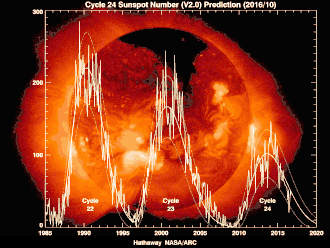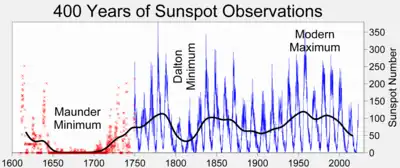Solar maximum
Solar maximum is the regular period of greatest solar activity during the Sun's 11-year solar cycle. During solar maximum, large numbers of sunspots appear, and the solar irradiance output grows by about 0.07%.[2] On average, the solar cycle takes about 11 years to go from one solar maximum to the next, with duration observed varying from 9 to 14 years.


Large solar storms often occur during solar maximum. For example, the Carrington Event, which took place a few months before the solar maximum of solar cycle 10, was the most intense geomagnetic storm in recorded history and widely considered to have been caused by an equally large solar storm.[3]
Predictions
Predictions of a future maximum's timing and strength are very difficult; predictions vary widely. There was a solar maximum in 2000. In 2006, NASA initially expected a solar maximum in 2010 or 2011, and thought that it could be the strongest since 1958.[4] However, the solar maximum was not declared to have occurred until 2014, and even then was ranked among the weakest on record.[5]
Grand solar minima and maxima
In addition to the ~11 year solar cycle, the intensity of the solar maxima can vary from cycle to cycle. When several solar cycles exhibit greater than average activity for decades or centuries, this period is labelled "Grand solar maximum". Solar cycles still occur during these grand solar maximum periods, but the intensity of those cycles is greater. Likewise, extended periods in which the solar maximum is lower than average are labeled "grand solar minima". Some researchers suggest that grand solar maxima have shown some correlation with global and regional climate changes, although others dispute this hypothesis (e.g., see Medieval Warm Period).
Following the advent of telescopic solar observation with Galileo's 1611 observations, the intensity of solar maxima is typically measured by counting numbers and size of sunspots; for periods previous to this, isotope ratios in ice cores can be used to estimate solar activity. The table below shows the approximate dates of some of the proposed solar minima in historical times.

| Event | Start | End |
|---|---|---|
| Homeric minimum[6] | 950BC | 800BC |
| Oort minimum | 1040 | 1080 |
| Medieval maximum | 1100 | 1250 |
| Wolf minimum | 1280 | 1350 |
| Spörer Minimum | 1450 | 1550 |
| Maunder Minimum | 1645 | 1715 |
| Dalton Minimum | 1790 | 1820 |
| Modern Maximum | 1914 | 2008 |
| Unspecified | 2009 | present |
A proposed list of historical Grand minima of solar activity[7] includes also Grand minima ca. 690 AD, 360 BC, 770 BC, 1390 BC, 2860 BC, 3340 BC, 3500 BC, 3630 BC, 3940 BC, 4230 BC, 4330 BC, 5260 BC, 5460 BC, 5620 BC, 5710 BC, 5990 BC, 6220 BC, 6400 BC, 7040 BC, 7310 BC, 7520 BC, 8220 BC, 9170 BC.
See also
- Solar wind
- Solar variation
- Solar minimum
- List of solar cycles – table of solar cycles
References
- NASA
- C. D. Camp & K. K. Tung (2007). "Surface warming by the solar cycle as revealed by the composite mean difference projection" (PDF). Geophysical Research Letters. 34 (14): L14703. Bibcode:2007GeoRL..3414703C. doi:10.1029/2007GL030207. Retrieved 20 January 2012.
- "Monster radiation burst from Sun". BBC News. 14 May 2013. Retrieved 2015-01-06.
- "Solar Storm Warning", Science@NASA, 10 March 2006, Accessed 26 Mar. 2010
- "Solar Mini-Max". NASA. Retrieved 2014-12-24.
- Celia Martin-Puertas; Katja Matthes; Achim Brauer; Raimund Muscheler; et al. (April 2, 2012). "Regional atmospheric circulation shifts induced by a grand solar minimum". Nature Geoscience. 5 (6): 397–401. Bibcode:2012NatGe...5..397M. doi:10.1038/ngeo1460.
- Usoskin, Ilya G.; Solanki, Sami K.; Kovaltsov, Gennady A. (2007). "Grand minima and maxima of solar activity: new observational constraints" (PDF). Astron. Astrophys. 471 (1): 301–9. arXiv:0706.0385. Bibcode:2007A&A...471..301U. doi:10.1051/0004-6361:20077704. S2CID 7742132.
